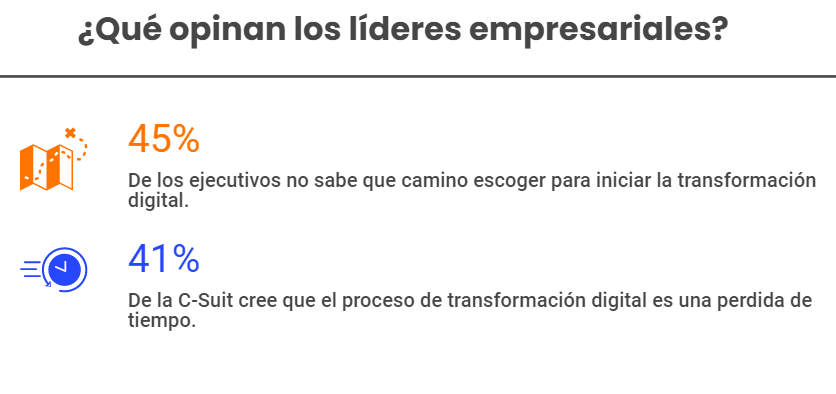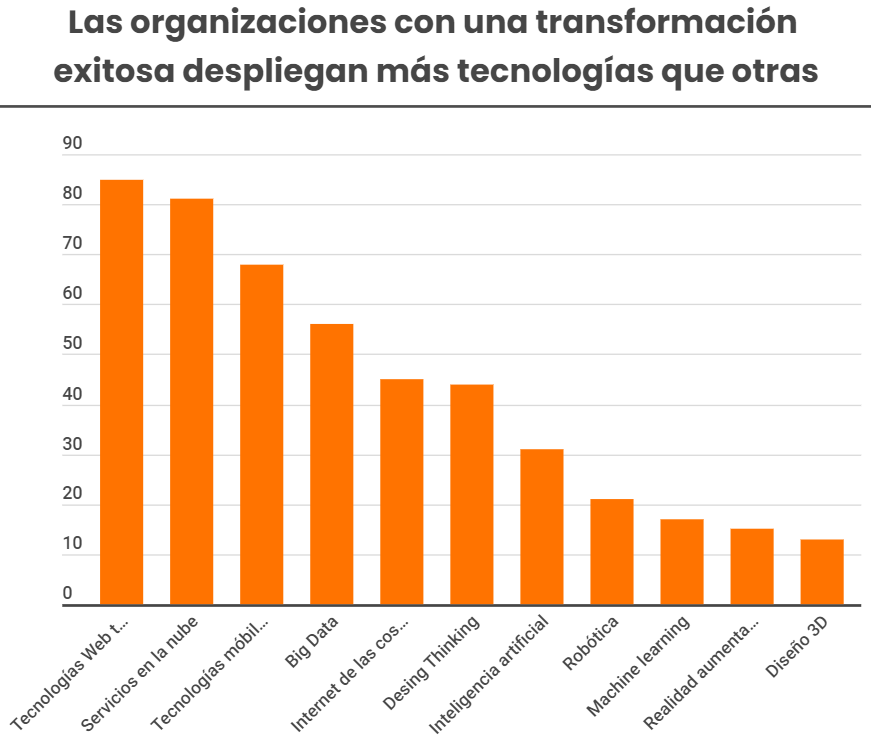Is digital transformation a waste of time?

There is no doubt that economies and processes are changing due to the evolution of technology, automation and the adoption of new systems and tools.
This situation has forced companies to restructure their business models and strategies before reaching their development peak, “decay” or threatened when competing companies are at the threshold of change Significant.
A digital mindset change
Right now, large companies have already begun their changes in digital sales strategies. For example, Starbucks has begun to transform and compromise the customer experience through the use of digital tools. Its commitment to the consumer allowed the company to collect more than 50,000 ideas of innovation, all led by customer vision and business change. However, a change requires preparation and a foundation, consisting mainly of valuable data.
The latest reports submitted at the end of 2018 on digital transformation suggest that companies should initiate their changes by “cleaning up” their current data and raising the new requirements for future data that will form an asset and a basis for the Change.
For example, a Fortune 1000 company, and investing in increasing the analysis of only 10% valuable data, could earn up to $65 million in net income.
Because sales are closely related to the company’s strategy, and while there are political, economic and technological uncertainties, companies must be prepared to respond “quickly” to new developments. The key to this responsiveness is to be agile by listening to customers, supporting employees, and applying modern business models and methodologies.
The company Del Monte Foods, Inc has managed to gain more visibility into its IT operations, reduce IT spending costs by up to 35% and increase operational efficiencies by significantly reducing the time it takes its professionals to receive it support from weeks to less than an hour, thanks to its migration to Amazon Web Services (AWS).
Still, at least 45% business executives don’t know where to start developing their transformation strategy. Worse, more than four out of ten (41%) senior leaders who have already started this process believe that transforming their business has been a waste of time.

New digital businesses
Although the definition of a business model differs depending on how professional is asked, everyone agrees that new business models must allow an organization to capture, create, and deliver value through data to meet explicit needs or Latent.
These needs have triggered the development of different methods and concepts including, among others, the Strategic Development Framework (FSSD), which is a continuous learning process that incorporates other methods, tools and concepts into a vision the overall shared and structured Canvas Business Model (BMC), which is a generic approach to business model design, and the Blue Ocean Strategy, which presents a systematic approach to making competition irrelevant and capturing its own” blue oceans.”
A great example of how the Blue Ocean strategy offers great benefits is the iTunes company, as it solved the problem of the record industry with illegal music downloads and, at the same time responding to the demand for digital songs on demand , thanks to the union of five companies in the music sector (BMG, EMI Group, Sony, Universal Music Group and Warner Brothers Records).
On the other hand, the hotel chain citizenM, thanks to the Blue Ocean strategy, managed to get the company to occupancy rates of the 90%, while enjoying costs 40% lower and gets the highest scores in the industry by opening up to the luxury market since more affordable hotels.
But not only can private companies profit from these strategies, for example, the New York Police Department, thanks to this plentifully, in less than two and a half years and without increasing budgets, it managed to get serious crimes to fall in 39%, the murders in a 50% and the robberies in a 35%.
Workers, a key point
As already seen, new technologies are transforming global businesses. Sectors are converging and a competitor today can be a partner in the future, or vice versa.
However, as companies invest in innovation, they are also aware that no progress can guarantee success in a fast-moving world. That’s why, in addition to investing in technology, it’s important to invest in the workforce.
Today, 45% of the world’s business leaders agree that they have trouble finding candidates with the necessary skills. This skills gap has left companies with few human resources and limited growth prospects, but it is the companies themselves that have the opportunity to close it.
The emergence of technologies such as artificial intelligence or data analysis are increasingly relevant to business practices. Which means companies need their workers to have some fluency in these areas, regardless of their professional background. That’s why nearly 70% of the companies intend to invest in artificial intelligence, machine learning or cloud services.

However, these good intentions are not always fulfilled, as only 32% of the top executives intend to invest more to gain better visibility into their processes. In addition, 79% admits that it does not review its internal business processes to understand what should be prioritized when setting initial objectives. Although 77%, he recognizes that things would do better with his digital initiatives if they reviewed these areas.

To get there, open and deep communication is key to real change. C-suite executives need to talk to their employees and involve them in identifying, analyzing, and designing processes. If the transformation is done from the workforce, any process that is not easy to implement will simply be circumvented by unofficial solutions.
Of course, open communication lays the foundation for other steps that need to be taken to make digital transformation beneficial and not a return-free investment.
For example, the US company Monsanto of biotechnology and agrochemicals launched a cloud analytics platform called “Science’s scale” to facilitate collaboration between the company’s scientists and data experts. Work that was previously completed in months is now done in hours, saving the company $15 million in operating costs and forecasting to increase them to $17 million.
Financial institutions, the most in need
Until now, there has been talk of companies belonging to various sectors, both public and private, however, financial institutions stand out for their need to initiate a complete digital transformation.
In this case, the biggest driver of transformation lies in improving the responsiveness to the growth needs of the business according to 35% financial leaders. As financial institutions seek new opportunities related to open banking, blockchain solutions, comprehensive client lifecycle management and automated investment advice.
In addition, half of leaders say that the employee attement rate is higher than expected, highlighting the urgency of adopting innovative technologies, such as natural language processing and artificial intelligence, that can improve employee skills and knowledge, which in turn improves their productivity, helping them better guide the business in areas such as third-party privacy and regulation.
However, it’s not all good news, TSB, one of the leading banks in the UK, is a good example when it comes to showing how difficult it can be for banks to upgrade their digital infrastructure.
In his case, a bad digital approach led to a massive IT failure that blocked nearly 1.9 million account holders and led in turn to lose nearly $260 million.
However, TSB is not alone. Over the years, many banks have struggled to update their technology. Whether it’s RBS Bank, HDFC Bank or TD Bank, the reality is that being cautious is key to the success of digital transformations in the financial services industry.
Interestingly, 58% of the financial services organizations are also considering partnering with an external consultancy to help accelerate their digital transformation while mitigating the risks they might face as a direct result of the updating and adopting new technologies.
Whether it’s driving change from within or with the help of consultants and consultants, financial services companies need to realize that time is running out and that they must act quickly if they want to maintain their market share, and make an exi debut in new markets.
Conclusions
Today, organizations that generate and use data are more successful than their competitors who don’t. However, that change must be initiated in the business leadership, with an executive board that understands the importance of data management and with a leadership team eager to obtain quality data, as well as understanding that these ideas are the driving force behind the successful transformation of the business.
It is important to note that the company should not necessarily be “digital native” like iTunes, Netflix or Uber to systematize innovation through digital perspectives. All you need is a solid foundation, formed by a digital strategy and a willingness to reimagine your business model, products and services and support structures.
Achieving the expected level of transformation will require data literacy skills that permeate a top-down organization, as well as in technologies such as artificial intelligence and machine learning to make sense of the datasets that are on the rise.


